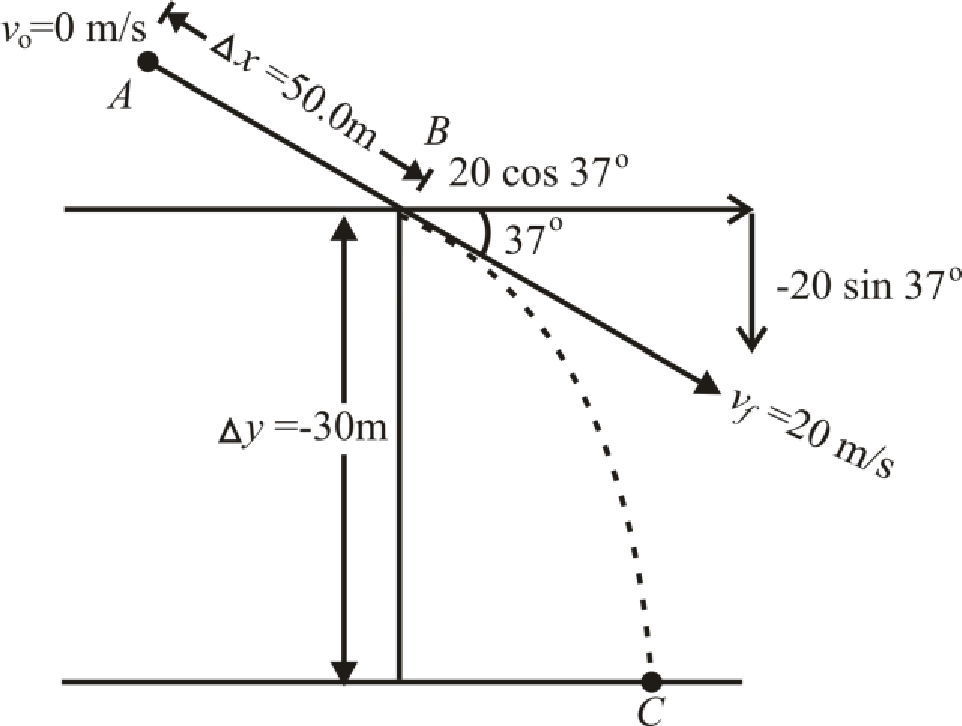
Concept explainers
(a)
The speed of the car at the edge of the cliff.
(a)
Answer to Problem 77AP
The speed of the car is
Explanation of Solution
Draw the below figure as per given instruction.

The car has acceleration while it is on the slope and a different acceleration when it is falling. Take the motion apart into two different sections.
A chunk of motion is during the acceleration stays constant. The acceleration will change instantaneously at the brink of the cliff. The velocity and the position must be the same just before point
From point
Write the expression for position along the incline plane as.
Here,
Conclusion:
Substitute
Solve and rearrange the above expression in terms of
Thus, the speed of the car is
(b)
The elapsed time interval.
(b)
Answer to Problem 77AP
The time elapsed time interval is
Explanation of Solution
Use first equation of motion for the time interval.
Write the expression for motion in straight line as.
Here,
Rearrange the above equation in terms of
Conclusion:
Substitute
Thus, the time elapsed time interval is
(c)
The velocity of the car.
(c)
Answer to Problem 77AP
The velocity of the car is
Explanation of Solution
Initial velocity is same as final velocity as horizontal acceleration is zero for uniform velocity. The velocity can be written as initial and final velocity component.
Write the expression for final velocity along horizontal as.
Here,
Write the expression for initial velocity along vertical as.
Here,
Write the expression for final velocity in
Here,
Rearrange the above expression as final velocity as.
Write the expression for total velocity for the whole distance as.
Here,
Conclusion:
Substitute
Substitute
Substitute
Substitute
Thus, the velocity of the car is
(d)
The total time interval the car is in motion.
(d)
Answer to Problem 77AP
The time interval for the total journey is
Explanation of Solution
Refer to drawn figure, the total time interval can be written as the sum of time required to cover distance
Write the expression for total time interval as.
Here,
Write the expression for time required to cover distance
Conclusion:
Substitute
Substitute
Thus, the time interval for the total journey is
(e)
The position of the car.
(e)
Answer to Problem 77AP
The horizontal distance covered by the time
Explanation of Solution
Write the expression for horizontal distance in time
Conclusion:
Substitute
Thus, the horizontal distance covered by the time
Want to see more full solutions like this?
Chapter 4 Solutions
Physics for Scientists and Engineers With Modern Physics
- need help part a and barrow_forwardComplete the table below for spherical mirrors indicate if it is convex or concave. Draw the ray diagrams S1 10 30 S1' -20 20 f 15 -5 Marrow_forwardA particle with a charge of − 5.20 nC is moving in a uniform magnetic field of (B→=−( 1.22 T )k^. The magnetic force on the particle is measured to be(F→=−( 3.50×10−7 N )i^+( 7.60×10−7 N )j^. Calculate the scalar product v→F→. Work the problem out symbolically first, then plug in numbers after you've simplified the symbolic expression.arrow_forward
- Need help wity equilibrium qestionarrow_forwardneed answer asap please thanks youarrow_forwardA man slides two boxes up a slope. The two boxes A and B have a mass of 75 kg and 50 kg, respectively. (a) Draw the free body diagram (FBD) of the two crates. (b) Determine the tension in the cable that the man must exert to cause imminent movement from rest of the two boxes. Static friction coefficient USA = 0.25 HSB = 0.35 Kinetic friction coefficient HkA = 0.20 HkB = 0.25 M₁ = 75 kg MB = 50 kg P 35° Figure 3 B 200arrow_forward
- A golf ball is struck with a velocity of 20 m/s at point A as shown below (Figure 4). (a) Determine the distance "d" and the time of flight from A to B; (b) Determine the magnitude and the direction of the speed at which the ball strikes the ground at B. 10° V₁ = 20m/s 35º Figure 4 d Barrow_forwardThe rectangular loop of wire shown in the figure (Figure 1) has a mass of 0.18 g per centimeter of length and is pivoted about side ab on a frictionless axis. The current in the wire is 8.5 A in the direction shown. Find the magnitude of the magnetic field parallel to the y-axis that will cause the loop to swing up until its plane makes an angle of 30.0 ∘ with the yz-plane. Find the direction of the magnetic field parallel to the y-axis that will cause the loop to swing up until its plane makes an angle of 30.0 ∘ with the yz-plane.arrow_forwardA particle with a charge of − 5.20 nC is moving in a uniform magnetic field of (B→=−( 1.22 T )k^. The magnetic force on the particle is measured to be (F→=−( 3.50×10−7 N )i^+( 7.60×10−7 N )j^. Calculate the y and z component of the velocity of the particle.arrow_forward
 Principles of Physics: A Calculus-Based TextPhysicsISBN:9781133104261Author:Raymond A. Serway, John W. JewettPublisher:Cengage Learning
Principles of Physics: A Calculus-Based TextPhysicsISBN:9781133104261Author:Raymond A. Serway, John W. JewettPublisher:Cengage Learning Glencoe Physics: Principles and Problems, Student...PhysicsISBN:9780078807213Author:Paul W. ZitzewitzPublisher:Glencoe/McGraw-Hill
Glencoe Physics: Principles and Problems, Student...PhysicsISBN:9780078807213Author:Paul W. ZitzewitzPublisher:Glencoe/McGraw-Hill Physics for Scientists and Engineers, Technology ...PhysicsISBN:9781305116399Author:Raymond A. Serway, John W. JewettPublisher:Cengage Learning
Physics for Scientists and Engineers, Technology ...PhysicsISBN:9781305116399Author:Raymond A. Serway, John W. JewettPublisher:Cengage Learning Classical Dynamics of Particles and SystemsPhysicsISBN:9780534408961Author:Stephen T. Thornton, Jerry B. MarionPublisher:Cengage Learning
Classical Dynamics of Particles and SystemsPhysicsISBN:9780534408961Author:Stephen T. Thornton, Jerry B. MarionPublisher:Cengage Learning University Physics Volume 1PhysicsISBN:9781938168277Author:William Moebs, Samuel J. Ling, Jeff SannyPublisher:OpenStax - Rice University
University Physics Volume 1PhysicsISBN:9781938168277Author:William Moebs, Samuel J. Ling, Jeff SannyPublisher:OpenStax - Rice University College PhysicsPhysicsISBN:9781285737027Author:Raymond A. Serway, Chris VuillePublisher:Cengage Learning
College PhysicsPhysicsISBN:9781285737027Author:Raymond A. Serway, Chris VuillePublisher:Cengage Learning





